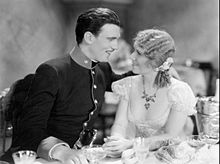
Otto Abels Harbach, born Otto Abels Hauerbach was an American lyricist and librettist of nearly 50 musical comedies and operettas. Harbach collaborated as lyricist or librettist with many of the leading Broadway composers of the early 20th century, including Jerome Kern, Louis Hirsch, Herbert Stothart, Vincent Youmans, George Gershwin, and Sigmund Romberg. Harbach believed that music, lyrics, and story should be closely connected, and, as Oscar Hammerstein II's mentor, he encouraged Hammerstein to write musicals in this manner. Harbach is considered one of the first great Broadway lyricists, and he helped raise the status of the lyricist in an age more concerned with music, spectacle, and stars. Some of his more famous lyrics are "Smoke Gets in Your Eyes", "Indian Love Call" and "Cuddle up a Little Closer, Lovey Mine".
This is a list of notable events in music that took place in the year 1930.

Sigmund Romberg was a Hungarian-born American composer. He is best known for his musicals and operettas, particularly The Student Prince (1924), The Desert Song (1926) and The New Moon (1928).
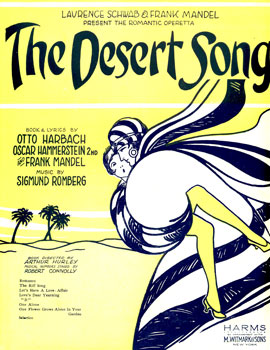
The Desert Song is an operetta with music by Sigmund Romberg and book and lyrics by Oscar Hammerstein II, Otto Harbach and Frank Mandel. It was inspired by the 1925 uprising of the Riffs, a group of Berber fighters, against French colonial rule in Morocco. It was also inspired by stories of Lawrence of Arabia aiding native guerrillas. Many tales romanticizing Saharan North Africa were in vogue, including Beau Geste and The Son of the Sheik.
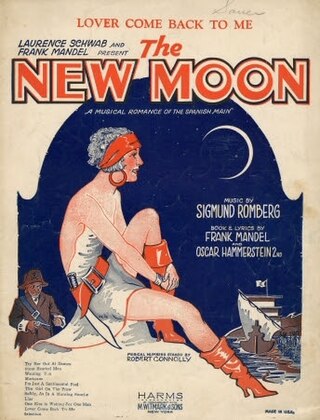
The New Moon is an operetta with music by Sigmund Romberg, lyrics by Oscar Hammerstein II and book by Oscar Hammerstein II, Frank Mandel, and Laurence Schwab. The show was the third in a string of Broadway hits for Romberg written in the style of Viennese operetta. Set around the time of the French Revolution, the story centers on a young French aristocrat in disguise, who has fled his country and falls in love with the daughter of a prominent New Orleans planter.

Song of the West is a 1930 American Pre-Code musical Western film produced by Warner Bros., and photographed entirely in Technicolor. It was based on the 1928 Broadway musical Rainbow by Vincent Youmans (music), Oscar Hammerstein II (lyrics) and Laurence Stallings (book). It starred John Boles, Joe E. Brown and Vivienne Segal, and was the first all-color all-talking feature to be filmed entirely outdoors.
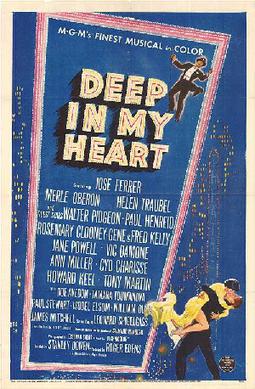
Deep in My Heart is a 1954 American MGM biographical musical film about the life of operetta composer Sigmund Romberg, who wrote the music for The Student Prince, The Desert Song, and The New Moon, among others. Leonard Spigelgass adapted the film from Elliott Arnold's 1949 biography of the same name. Roger Edens produced, Stanley Donen directed and Eugene Loring choreographed. José Ferrer played Romberg, with support from soprano Helen Traubel as a fictional character and Merle Oberon as actress, playwright, librettist, producer, and director Dorothy Donnelly.

Song of the Flame is a 1930 American pre-Code musical film photographed entirely in Technicolor. Based on the 1925 operetta of the same name, the film features a screenplay by Gordon Rigby adapted from the musical book written by Oscar Hammerstein II and Otto A. Harbach for the operetta. The movie also features many of the songs from the operetta which used lyrics by Hammerstein and Orbach and music by George Gershwin and Herbert Stothart. The film was produced and distributed by First National Pictures. It was the first color film to feature a widescreen sequence, using a process called Vitascope, the trademark name for Warner Bros.' widescreen process. The film, based on the 1925 Broadway musical of the same name, was nominated for an Academy Award for Sound Recording. It is part of the tradition of operetta films, popular at the time.

Golden Dawn is a 1930 Warner Bros. American pre-Code musical operetta film directed by Ray Enright that was photographed entirely in Technicolor. It stars Vivienne Segal, Walter Woolf King and Noah Beery.

Bride of the Regiment is a 1930 American pre-Code musical film directed by John Francis Dillon and filmed entirely in Technicolor. The screenplay by Ray Harris and Humphrey Pearson is based on the book of the 1922 stage musical The Lady in Ermine by Frederick Lonsdale and Cyrus Wood, which had been adapted from the 1919 operetta Die Frau im Hermelin by Rudolph Schanzer and Ernst Welisch. The story is a remake of a 1927 First National silent film, The Lady in Ermine, that starred Corinne Griffith. It was later remade by 20th Century-Fox as That Lady in Ermine (1948) starring Betty Grable and Douglas Fairbanks Jr.

Fifty Million Frenchmen is a 1931 American pre-Code Technicolor musical comedy film directed by Lloyd Bacon. The film was produced and released by Warner Brothers and was based on Cole Porter's 1929 Broadway musical Fifty Million Frenchmen.
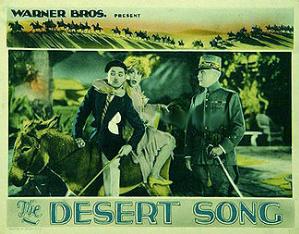
The Desert Song is a 1929 American pre-Code operetta film directed by Roy Del Ruth and starring John Boles, Carlotta King, Louise Fazenda, and Myrna Loy. It was photographed partly in two-color Technicolor, the first film released by Warner Bros. to include footage in color. The film included a 10-minute intermission during which music was played.

Paris is a 1929 American pre-Code musical comedy film, featuring Irène Bordoni. It was filmed with Technicolor sequences: four of the film's ten reels were originally photographed in Technicolor.

Men of the Sky is a 1931 all-talking American pre-Code musical drama film, directed by Albert E. Green which was produced by Warner Bros. in 1930 and released in 1931. Men of the Sky stars Irene Delroy and Jack Whiting. Although aircraft were seen in the film, Men of the Sky was more of a spy drama.
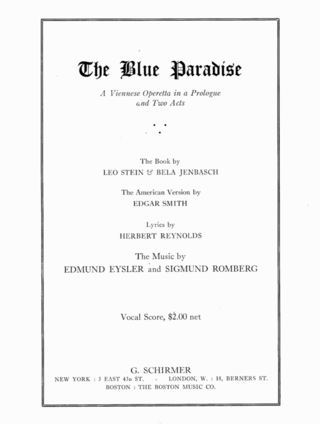
The Blue Paradise is a musical in a prologue and two acts, with music by Edmund Eysler, Sigmund Romberg and Leo Edwards, lyrics primarily by Herbert Reynolds, and a book by Edgar Smith, based on the operetta Ein Tag im Paradies by Eysler with original text by Leo Stein and Bela Jenbach. The story is set in a Viennese cafe, where a man realizes that he cannot recapture his long lost love.

The Cat and the Fiddle is a 1934 American pre-Code romantic musical film directed by William K. Howard based on the hit 1931 Broadway musical of the same name by Jerome Kern and Otto A. Harbach, about a romance between a struggling composer and an American singer. The film stars Ramon Novarro and Jeanette MacDonald in her MGM debut.
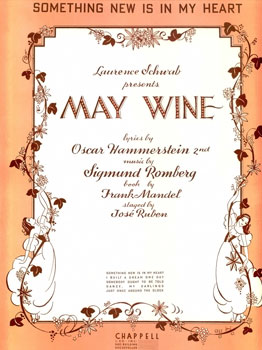
May Wine is a musical with a book by Frank Mandel, lyrics by Oscar Hammerstein II, and music by Sigmund Romberg. The show was adapted from the novel The Happy Alienist by Eric von Stroheim and Wallace Smith. The story concerns the rich and absent-minded psychology professor, Johann Volk, who falls in love with Marie. The malevolent Baron Kuno Adelhorst, who also loves Marie, tries to get the professor's money by having Marie marry him, but after they are married she comes to love the professor and does not want to blackmail him. However, the Professor thinks he has been deceived and tries to shoot Marie. He does not hurt her, and all ends well. The subplot involves an artist's model, Friedl, who wants a man's attention and gets it from the Baron.
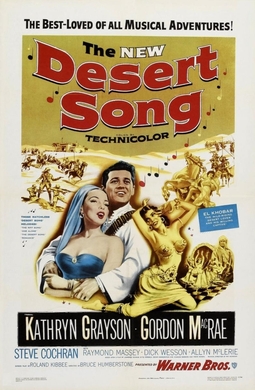
The Desert Song is a 1953 film version in Technicolor of Sigmund Romberg's operetta. It is the third film version of the operetta, the third made by Warner Bros., and the second in full three-strip Technicolor. Although it was released in 1953, it was not made in widescreen; at that time Twentieth-Century Fox held the rights to Cinemascope, which was introduced that year in the film The Robe.
New Moon is a 1930 black-and-white American, pre-Code romantic/drama/melodrama musical film version of the operetta The New Moon, with music by Sigmund Romberg and book and lyrics by Oscar Hammerstein II and others. The original stage version premiered on Broadway in 1928. The 1930 film is also known as Komissa Strogoff in Greece, Nymånen in Denmark and Passione cosacca in Italy. A second adaptation, also titled New Moon, was released in 1940.
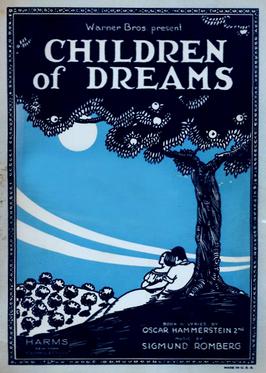
Children of Dreams is a 1931 American pre-Code musical operetta drama film photographed entirely in Part Technicolor and produced and distributed by Warner Bros.

